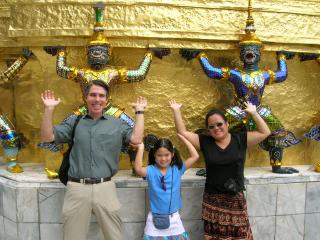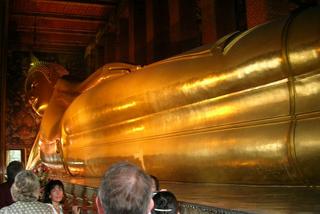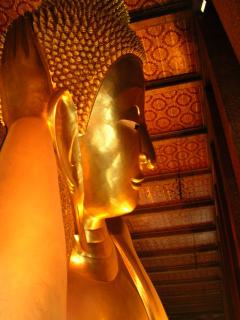Bangkok Thailand: Wat a day!
I know, terrible pun, but there must be a bazillion wats in Thailand and we saw some of the most famous and important ones in Bangkok on Sunday. A wat is a temple, a historic monument as well as a living house of worship for Thai Buddhists. We went to Wat Phra Kaew, Wat Pho and Wat Arun with new friends Samai and her 8 year old niece who I’m going to call Nola, because no matter how many times we asked her her name, we could never understand exactly how she pronounced it. The closest approximation I can come to what she would say is Nola. Sorry. Samai is the sister of the woman who owns the condo where we are staying. Amazingly it was her first time to Wat Phra Kaew or Wat Pho, so we didn’t feel too guilty because we weren’t dragging her along to tourist sights she had seen a million times.

Pictures do not do justice to Wat Phra Kaew and the Grand Palace that adjoins it.

It is a huge, over-the-top, gilded series of buildings that have statutes, mirrored surfaces, soaring rooflines (like the typical Thai architecture) and most importantly a small green emerald Buddha, elevated high above the masses. Three times a year the King of Thailand comes and puts a different outfit on the Buddha, one for each season: hot, cool and rainy.


Wat Pho houses the longest reclining in Buddha in Thailand, if not the world. It is 46 meters (150 feet) long and 15 meters (50 feet) high. This is a representation of Buddha reaching nirvana at his death and it has a peaceful sense to it.

On the bottoms of his feet, mother of pearl inlays show different aspects of the Buddha. Samai bought us some incense we could light, as well as lotus flowers that we placed by one of the altars, and a small fleck of gold that we were to rub on a smaller Buddha at the altar. I think Dylan was more intrigued by the tiny flecks of gold than by the huge Buddha!

Both of these wats were swarming with tourists, in fact we’ve seen more westerners here than anywhere else we’ve been in Asia. Despite the post-tsunami recovery, and the dire predictions of avian flu, it seems we are not the only ones taking to exotic destinations these days and in some ways, there is comfort in numbers (despite the fact that most other western tourists seem to be 15 years younger or older than we are).
Wat Arun, the third wat we visited, is named after the Indian god of dawn, which might explain its striking similarities to the Hindu temples in India, with the thousands of gods and animals along the sides of the wat. Incredibly steep steps climb the sides of the wat, and it felt like we would pitch forward if we weren’t careful coming down.

We rode the river taxi along the Chao Phraya river, which has been the heart of Bangkok and the avenue of travel for hundreds of years for both locals and tourists alike.

After a long hot day of visiting wats, we stopped at the historic, opulent Oriental Hotel for a pricey drink and free aircon.

Pictures do not do justice to Wat Phra Kaew and the Grand Palace that adjoins it.

It is a huge, over-the-top, gilded series of buildings that have statutes, mirrored surfaces, soaring rooflines (like the typical Thai architecture) and most importantly a small green emerald Buddha, elevated high above the masses. Three times a year the King of Thailand comes and puts a different outfit on the Buddha, one for each season: hot, cool and rainy.


Wat Pho houses the longest reclining in Buddha in Thailand, if not the world. It is 46 meters (150 feet) long and 15 meters (50 feet) high. This is a representation of Buddha reaching nirvana at his death and it has a peaceful sense to it.

On the bottoms of his feet, mother of pearl inlays show different aspects of the Buddha. Samai bought us some incense we could light, as well as lotus flowers that we placed by one of the altars, and a small fleck of gold that we were to rub on a smaller Buddha at the altar. I think Dylan was more intrigued by the tiny flecks of gold than by the huge Buddha!

Both of these wats were swarming with tourists, in fact we’ve seen more westerners here than anywhere else we’ve been in Asia. Despite the post-tsunami recovery, and the dire predictions of avian flu, it seems we are not the only ones taking to exotic destinations these days and in some ways, there is comfort in numbers (despite the fact that most other western tourists seem to be 15 years younger or older than we are).
Wat Arun, the third wat we visited, is named after the Indian god of dawn, which might explain its striking similarities to the Hindu temples in India, with the thousands of gods and animals along the sides of the wat. Incredibly steep steps climb the sides of the wat, and it felt like we would pitch forward if we weren’t careful coming down.

We rode the river taxi along the Chao Phraya river, which has been the heart of Bangkok and the avenue of travel for hundreds of years for both locals and tourists alike.

After a long hot day of visiting wats, we stopped at the historic, opulent Oriental Hotel for a pricey drink and free aircon.

0 Comments:
Post a Comment
<< Home